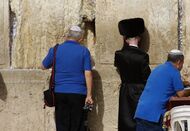Frum
Topic: Religion
 From HandWiki - Reading time: 4 min
From HandWiki - Reading time: 4 min
Frum (Yiddish: פֿרום, lit. 'religious', 'pious') is a word that describes Jewish religious devotion.
The term connotes the observance of Jewish religious law in a way that often exceeds its bare requirements. This not only includes the careful study of Torah, daily prayers, observing Shabbat and kashrut, and performing deeds of loving-kindness, but also many more customs and khumrot (prohibitions or obligations in Jewish life that exceed the requirements of Halakha).[1][2]
The term frum contrasts with frei (Yiddish: פֿרײַ, lit. 'free'), which describes Jews who are secular or practice non-Orthodox observance, or "free from keeping the… commandments."[3][4]
Meaning
Frum can be used in a negative sense for 'hypocritically pious', 'holier-than-thou', 'sanctimonious'; or in a positive sense for 'pious', 'devout', 'God-fearing', and 'upright'. The phrase frum and ehrlich captures the positive connotations of these words, to mean roughly 'upright' or 'righteous' (see tzadik).[citation needed]
The question "is s/he frum?" asks whether the person is religious.[1]
Derived terms
In Yinglish, frummer is used both as a noun for 'one who is frum'[5] and as a comparative adjective, i.e. 'more frum'.[6][7] The prescribed Yiddish comparative form of the adjective is, in fact, frimer.[8][9][10] Frumkeit describes the lifestyle of those who are frum.[5]
Frummer can also have a negative connotation, similar to chasid shoteh ('pious idiot'), which is how the Talmud (Sotah 21B) describes a man who sees a woman drowning but refuses to save her, saying: "It is not proper to look at her, and rescue her." A frummer in that sense is a person displaying a disproportionate emphasis on technical aspects of religion of one's daily life in a manner which actually violates the halakha in a specific case. (See Pikuach nefesh.) Another term with this meaning is frummie.[5]
A person who is frum from birth (FFB) was born into a frum household and has remained observant.[11][12][13] This contrasts with a baal teshuva (BT), which literally means 'master of return' and refers to a Jew who has become frum after a period or lifetime of following a non-Orthodox lifestyle.[14][15] Someone who leaves the frum lifestyle would be referred to as off the derech (OTD), which literally means 'off the path.'
The Frumba exercise program originated in Chicago as a derivation of the dance-based fitness program Zumba.[16] Frumba classes are offered exclusively to women who observe frum forms of tzniut modesty laws, featuring music with less explicit lyrics.[17]
Mode of dress
Frum Jews are expected to dress in gender-specific, modest, low-cut clothing adherent to standards outlined by Jewish religious law. Women dress in loose skirts and dresses that cover their arms and legs.[18] When married, they cover their heads with scarves and wigs. Jewish men wear fringed undershirts known as tallitot katan, and head coverings often in the style of kippot.[19] Although applicable to both sexes, particular emphasis is often placed upon the dressing guidelines of women.[20]
In addition to the tzniut style of dress, many frum Jews are identifiable by their traditional clothing. Black trenchcoats, fur hats, and other distinct Ashkenazic garb have become mainstream religious clothing across ethnic divisions.[21]
References
- ↑ 1.0 1.1 Dina Kraft (November 10, 2010). "Rapper Finds Order in Orthodox Judaism in Israel". The New York Times. https://www.nytimes.com/2010/11/11/arts/music/11shyne.html?_r=1.
- ↑ Zinoman, Jason (June 13, 2018). "What's So Funny About Orthodox Judaism? This Comic Has One Answer". The New York Times. https://www.nytimes.com/2018/06/13/arts/television/orthodox-jewish-comedian-ashley-blaker.html.
- ↑ Miller, Marjorie (July 25, 1997). "Freier". Los Angeles Times. https://www.latimes.com/archives/la-xpm-1997-jul-25-mn-16208-story.html.
- ↑ Roniger, L. (1992). "From pioneer to freier: the changing models". European Journal of Sociology 33 (2): 280–307. doi:10.1017/S0003975600006470.
- ↑ 5.0 5.1 5.2 Rabbi Julian Sinclair (November 5, 2008). "Frum". The Jewish Chronicle. https://www.thejc.com/judaism/jewish-words/frum-1.5971.
- ↑ Fried, Heshy (22 June 2011). "Words and statements that make you sound frummer [sic than you are"]. Frum Satire. http://www.frumsatire.net/2011/06/22/orthodox-jewish-terminology-and-words. Retrieved 29 March 2017.
- ↑ JewishPress.com Staff (26 March 2017). "Frummer [sic Than You"]. The Jewish Press. http://www.jewishpress.com/multimedia/photos/frummer-than-you/2017/03/26. Retrieved 29 March 2017.
- ↑ Kahn, Lily; Rubin, Aaron D., eds (2016). Handbook of Jewish Languages. Leiden, Netherlands: Koninklijke Brill NV. p. 676. ISBN 9789004297357. https://books.google.com/books?id=sG3sCgAAQBAJ&pg=PA676. Retrieved 29 March 2017. "ו (u) becomes י (i), e. g., פֿרום frum 'Jewishly observant' > פֿרימער frimer 'more Jewishly observant'"
- ↑ Stutchkoff, Nahum (1950). Weinreich, Max. ed (in Yiddish). דער אוצר פון דער יידישער שפראך (Der oytser fun der Yidisher shprakh). New York: Yidisher Ṿisenshafṭlekher Insṭiṭuṭ. https://archive.org/details/nybc201134. "די קאַץ איז שוין פֿרימער פֿאַר אים. ('Di kats iz shoyn frimer far im.' — 'A cat is more pious than he is.')"
- ↑ "פֿרום (Adjective)". https://en.wiktionary.org/wiki/%D7%A4%D6%BF%D7%A8%D7%95%D7%9D#Yiddish. Retrieved 29 March 2017.
- ↑ Sarah Bunin Benor (2012). "Becoming Frum". Becoming Frum: How Newcomers Learn the Language and Culture. Rutgers University Press. ISBN 978-0-8135-53894.
- ↑ Susan Jo Keller (September 20, 1998). "Seeing the Light". The New York Times. https://www.nytimes.com/1998/09/20/nyregion/in-person-seeing-the-light.html. "born in an observant Orthodox family"
- ↑ Tova Ross (December 10, 2013). "When I got married, my sheitel was a symbol of my vows and my Orthodoxy". https://www.tabletmag.com/jewish-life-and-religion/151283/no-more-sheitel.
- ↑ Rabbi Aaron L. Raskin. "Tzaddik — The Baal Teshuvah". https://www.chabad.org/library/article_cdo/aid/137090/jewish/Tzaddik-The-Baal-Teshuvah.htm.
- ↑ "Laws of Repentance 7:4, citing Berakot, 34b. C. G.". Mishneh Torah. https://www.sefaria.org/Mishneh_Torah%2C_Repentance.7?lang=bi. "their degree is above .. did not sin, because it is more difficult for them .."
- ↑ "JUF News : Tziporah Gelman -- 2013" (in en). https://www.c-j-c.org/news/local.aspx?id=451539.
- ↑ Blomquist, Mala. "Scottsdale joins international celebration of Shabbat" (in en). https://www.jewishaz.com/community/scottsdale-joins-international-celebration-of-shabbat/article_facc7fc6-6444-11ed-8fdd-9b12654540e8.html.
- ↑ Naomi Fry (November 2, 2017). "Modest Dressing, as a Virtue". https://www.nytimes.com/2017/11/02/t-magazine/modest-fashion-clothes.html. "ankle-lengthed, high-necked and voluminous-sleeved .. long-sleeved, high-collared"
- ↑ "What Is A Kippah?". https://www.myjewishlearning.com/article/kippah/.
- ↑ Laurie Novick. "What is Tzeniut?". https://www.deracheha.org/tzeniut/. "As a corollary to the concern that every Jew act with sexual propriety, there often seems to be a great focus specifically on women and tzeniut."
- ↑ "Sephardic Rabbis in Ashkenazic Garb!!!". https://www.jewishideas.org/blog/sephardic-rabbis-ashkenazic-garb.
 |
 KSF
KSF

